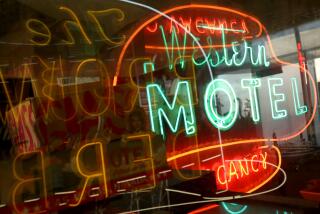The Mannequin as a Form of History : Collector Hopes to Display Collection, Archives in a Museum
- Share via
Not far from the spray of Pacific surf at Malibu, nearly 300 plastic and fiberglass forms lie in a sort of limbo, waiting to be reassembled for new lives on display.
And they may soon get it.
The mannequins, along with a vast collection of the photographs and documents Marsha Bentley Hale has collected over the last nine years, would be the chief attractions of what may be the world’s first mannequin museum. Hale, who hopes her project will turn the spotlight on a long-ignored corner of history, has secured a 20-acre tract overlooking the ocean in Malibu and hopes to be able to open the museum soon.
Mannequins are more than clothes horses, Hale says. They trace the story of fashion, mirror cultural trends and values and reveal society’s attitudes about sex roles, beauty and propriety.
‘Miss Modesty’
For example, she said, “there was one mannequin made in 1898 called Miss Modesty. She was modeling corsets. Her hands were crossed over her face and her head was inclined downward. That made a profound statement about a woman’s role in intimate situations.
“Now,” Hale said, “lingerie mannequins are quite direct. They look right at you. They’re not shy. Their eyes are even inviting sometimes.”
Hale’s archives, carefully preserved in a cramped Santa Monica apartment, include pictures of the streamlined Art Deco figures of the 1920s, the curvaceous women of the 1940s and the lean, leggy forms of the 1960s. The mannequins themselves are stored in a warehouse in Malibu, each in its own box labeled by date and manufacturer.
Hale’s obsession began with a photography class at UCLA in 1978. As she was searching for photographic subjects one night along posh Rodeo Drive in Beverly Hills, the sleek mannequins in the shop windows captured her imagination and she began clicking away. The rest, she says, is history.
“I couldn’t stop thinking about them,” Hale said. “They haunted me. They were so expressive, so evocative. I tried to find out everything about them. But I discovered there was nothing, nothing at all.”
Visits to New York, Europe
So she began her travels. She made visits to mannequin showrooms in New York, to a showcase of ventriloquists’ dummies in Kentucky, to Westminster Abbey in London, where she photographed the wax effigies of King Charles II, King William III and Queen Mary II. She toured mannequin factories all over Europe. People in remote European towns wrote her letters telling of old mannequins gathering dust in their attics, she said. She went to see them, then persuaded the owners either to sell her the figures or to let her photograph them.
Hale says the mannequin’s beginnings can be traced back to Egypt. The treasures of King Tutankhamen’s tomb, she said, include a wooden figure that was probably used to display robes and jewelry.
Other media have been used since that time. Mannequins have been made of wicker, wax, soldered metal and papier-mache. Some of those materials proved unsuitable, however. Wax melted, she said, and some of the plastics used in the 1940s turned a horrid shade of green in the heat of display windows. Since the ‘40s, she said, most mannequins have been made of fiberglass
More to Read
The biggest entertainment stories
Get our big stories about Hollywood, film, television, music, arts, culture and more right in your inbox as soon as they publish.
You may occasionally receive promotional content from the Los Angeles Times.










